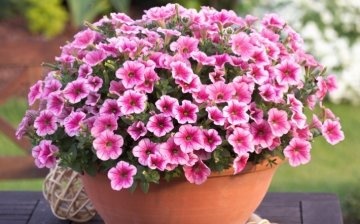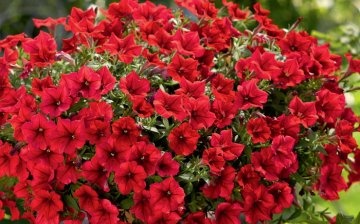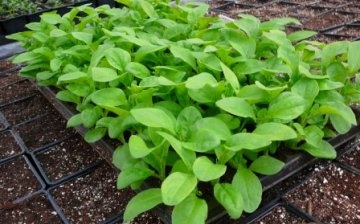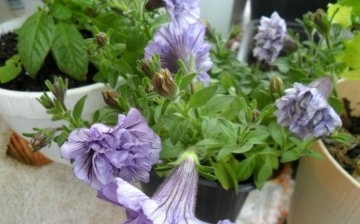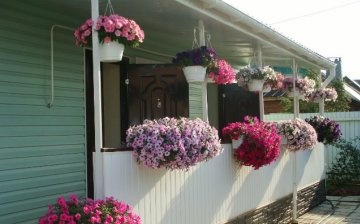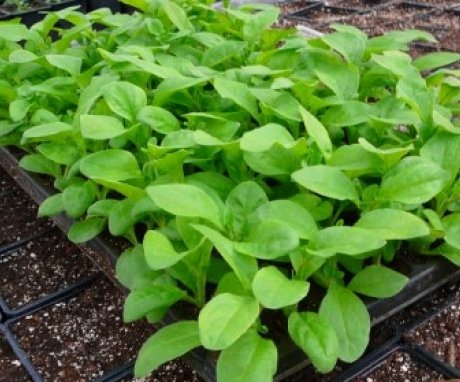Tips and Tricks: How to Grow Surfinia from Seeds
To obtain a beautiful and blooming decorative balcony, it is often used surfiniya, better known as ampelous petunia. Cascading clusters of bright flowers planted in planters give any terrace and any home an elegant and festive look. The plant is unpretentious in care and grows well and develops in almost all regions with warm summers.
Content:
General information about the plant
Surfinia is an annual herb that belongs to the petunia family. In length, the stems of the plant can grow up to 2 meters.
Flowers form 2 to 7 cm in diameter, depending on the variety.
Their shape is funnel-shaped with clearly defined segments, the color of the petals also depends on the variety and can be monochromatic or multi-colored. Also, flowers are simple and double. Leaves and stems are colored light green and covered with villi. The leaves are small in size, oblong-oval in shape with a pronounced central vein, not densely located on the stems.
Care
Uhod surfing is a fairly simple lesson:
- Surfinia loves bright and well-warmed places. Therefore, for planting or establishing a pots with a plant, it is recommended to choose a sunny place. There are no special preferences for the soil, but it is recommended to plant the plant in loose and light soil, previously fertilized with humus or compost. Also, water should not stagnate in these places, as this can lead to decay of the roots and the death of the entire surfinia area.
- Before planting, a thick layer of drainage is laid in the pots, after which the substrate is poured into which the plant will be planted. For such a planting, a soil can be purchased in a special gardening store.
- Watering produce regularly, especially for potted plants and planters. The water should not stagnate, but the earthen should not dry out. The roots of the plant are very thin and, with prolonged drying, die and break, after which the whole plant begins to wither. In the dry and hot summer period, many flower growers recommend watering surfiniya 3 times a day.
- You can pinch the top to get the plant to branch. Thereafter bloom stop for 3-4 weeks, but then it will resume 2-3 times thicker and more luxuriant. To keep the bush in a neat form, it is necessary to constantly remove faded flowers and dried leaves.
- Top dressing must be paid every week. For this, complex fertilizers for flowering plants, which contain a minimum of nitrogenous additives or they are absent at all. You can periodically spray the leaves of surfini with fertilizer.
Growing from seeds
Surfinia reproduces with the help seedthat can be collected from bushes or purchased at the store. The assortment includes regular seeds and pelleted ones. The former can give poor shoots due to the poor quality of the raw materials, the latter require moderate watering after planting, but such that the shell has time to dissolve. In the opposite case, seedlings will also be few.
Only fresh seeds are suitable for sowing, therefore, when buying, you need to carefully study the storage periods and the planting system for different types of seeds.Pelleted seeds are especially demanding in terms of storage conditions and time.
For landing you need:
- Prepare a container with light, loose soil that allows water and air to pass through well. Peat mixed with sand is suitable, or peat tablets.
- Since surfiniya seeds are very small, they are sown on the surface of the soil and are not sprinkled with earth on top. It is imperative to install a greenhouse over the seedlings using film or glass.
- Water the seeds with a spray bottle and regularly ventilate the greenhouse. There must be holes at the bottom of the container so that excess water does not accumulate at the bottom, but calmly goes out.
- We place the container with seedlings in a warm and bright room. The air temperature should be within 20-22 degrees Celsius. Crops must be protected from direct sunlight.
- Shoots should appear in 2 weeks. Professional florists recommend sprinkling the seedlings with calcined river sand during this period. This will protect the top of the plant and its roots from rotting and strengthen the root system. When the seedlings grow a little, the process can be repeated.
Picking carried out with plants that have already appeared two adult leaves. They are transferred to larger containers and placed in such a way that neighboring plants do not interfere with the growth and development of each other. When growing seedlings in peat tablets, a pick is not made, since one seed is planted in each separate plate.
When 5-7 adult leaves already appear on the plant, and the root system is sufficiently strengthened, they can be transplanted into a flower bed or in a pots on a balcony or terrace.
At the same time, you can combine plants with different colors of flowers for a brighter and more saturated ensemble. For seedlings the seeds sown in late March or early April. When disembarking in open ground it is necessary to wait for constantly warm weather so that the soil warms up by 3-4 cm.About this period falls at the end of May or the beginning of June.
Seedlings needed feed... This process begins already 3-4 weeks after the emergence of seedlings, it is carried out together with watering. For this, a complex fertilizer for flower plants is suitable. Concentration in the initial stages should be low. It is gradually increased to the required solution.
Diseases and pests
When planting hybrid varieties of surfinia, the probability of occurrence diseases is minimal. But with improper care and waterlogging of the soil, the plant may develop white rot or black leg. Treatment of such diseases almost never lead to good results, usually the plant dies. If such an ailment is found, it is recommended to remove the plant.
Of the pests, thrips, whiteflies and spider mites can attack the plant.
To combat them, it is recommended to process all the bushes several times with soapy water 2-3 times with an interval of 3-5 days. If such a procedure does not help, then it is necessary to purchase special means to combat pests.
To avoid problems with the plant, it must be regularly examined for the presence of pests or the appearance of infection. It is also worth monitoring the condition of the soil and the placement of the plant in the garden or balcony.
Application
Surfinia is mainly used to decorate terraces, balconies, gazebos and houses. She is planted in hanging pots and decorate the territory. Blooming waterfalls can often be found in the old cities of Europe. Bright surfiniya flowers can also be seen in the decorations of outdoor cafes and restaurant areas.
More information can be found in the video.



